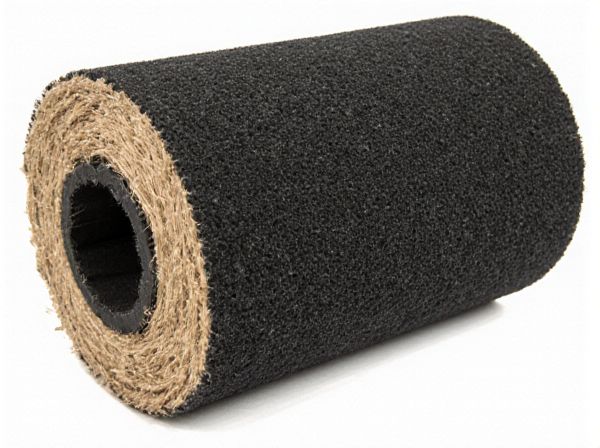
Photo illustration: Jute Padding vs Rubber Padding
Jute padding offers natural breathability and eco-friendliness, making it an excellent choice for sustainable cushioning solutions. Rubber padding provides superior durability and shock absorption, ideal for heavy-duty applications requiring long-lasting support. Consider your specific needs for comfort and environmental impact when choosing between these two padding materials.
Table of Comparison
| Feature | Jute Padding | Rubber Padding |
|---|---|---|
| Material Type | Natural fiber, biodegradable | Synthetic, durable rubber |
| Durability | Moderate, prone to moisture damage | High, resistant to moisture and wear |
| Comfort | Good cushioning, softer feel | Firm cushioning, less compressible |
| Noise Reduction | Moderate sound insulation | Excellent noise dampening |
| Eco-Friendliness | Highly eco-friendly and sustainable | Low, non-biodegradable material |
| Cost | Generally lower price | Usually higher price |
| Installation | Easy to trim and fit | Requires precise fitting and tools |
| Ideal Use | Eco-conscious, lightweight padding | Heavy-duty, long-lasting padding |
Introduction to Padding Materials
Jute padding, derived from natural plant fibers, offers eco-friendly insulation and cushioning in various applications like furniture and mattresses. Rubber padding, made from synthetic or natural latex rubber, provides superior elasticity, durability, and moisture resistance, making it ideal for heavy-duty footwear and industrial uses. Both materials serve distinct purposes in padding, with jute emphasizing sustainability and breathability, while rubber focuses on resilience and cushioning performance.
What is Jute Padding?
Jute padding is a natural, eco-friendly material made from the fibers of the jute plant, known for its durability and breathability. Commonly used in upholstery and mattress manufacturing, jute padding provides firm support and excellent ventilation, reducing moisture buildup. This biodegradable padding offers an environmentally sustainable alternative to synthetic options like rubber padding, which is often heavier and less breathable.
What is Rubber Padding?
Rubber padding is a cushioning material made from natural or synthetic rubber designed to provide enhanced shock absorption and durability in various applications such as upholstery, flooring, and industrial products. Known for its excellent elasticity and water resistance, rubber padding effectively reduces noise and vibration, making it ideal for protective purposes. Compared to jute padding, rubber padding offers superior longevity and resilience, particularly in environments exposed to moisture or heavy usage.
Key Differences Between Jute and Rubber Padding
Jute padding, made from natural fiber, offers eco-friendly, biodegradable cushioning with excellent breathability and moisture absorption, making it ideal for mattresses and upholstery. Rubber padding, derived from synthetic or natural rubber, provides superior durability, elasticity, and resistance to wear, often used in industrial applications requiring shock absorption and insulation. Key differences lie in material origin, environmental impact, and performance characteristics, with jute padding favoring sustainability and comfort, while rubber padding emphasizes resilience and longevity.
Durability: Jute vs Rubber Padding
Jute padding offers moderate durability with natural resistance to wear and tear, making it suitable for lightweight or moderate-use applications, while rubber padding excels in longevity due to its high elasticity and resistance to abrasion, moisture, and impacts. Rubber padding maintains structural integrity under heavy loads and frequent use, outperforming jute in environments prone to pressure and friction. Selecting between jute and rubber padding depends on the specific durability requirements, with rubber preferred for heavy-duty protection and jute for eco-friendly, sustainable options.
Comfort and Support Comparison
Jute padding offers a natural, breathable cushioning that provides firm support and excellent moisture absorption, making it ideal for temperature regulation and durability in mattresses and upholstery. Rubber padding, particularly natural or latex rubber, delivers superior elasticity and contouring support, enhancing pressure relief and comfort by adapting to body shape and movement. Comparing comfort and support, jute padding excels in firmness and airflow, while rubber padding stands out for its responsive, adaptive properties, catering to varied comfort preferences and ergonomic needs.
Environmental Impact and Sustainability
Jute padding is a biodegradable and renewable material derived from natural plant fibers, making it highly sustainable and environmentally friendly compared to rubber padding, which is often produced from synthetic or non-renewable resources. The production of jute padding generates lower carbon emissions and avoids harmful chemicals, whereas rubber padding contributes to pollution and landfill waste due to its longer degradation period. Choosing jute padding supports eco-conscious practices by reducing environmental footprint and promoting sustainable agriculture.
Cost Analysis: Jute vs Rubber Padding
Jute padding offers a cost-effective alternative to rubber padding, with raw material and manufacturing expenses significantly lower due to sustainable natural fibers and simpler processing methods. Rubber padding, while providing superior cushioning and durability, incurs higher costs driven by synthetic materials, complex production, and longer lifecycle advantages. Businesses prioritizing budget constraints often prefer jute padding for affordable eco-friendly bedding solutions, whereas rubber padding suits applications demanding enhanced resilience despite increased upfront investment.
Ideal Applications for Each Padding Type
Jute padding excels in upholstery and carpet underlay where natural breathability and eco-friendliness are prioritized, making it ideal for sustainable furniture and flooring projects. Rubber padding offers superior shock absorption and durability, suited for gym floors, industrial mats, and environments requiring heavy impact resistance. Choosing between jute and rubber padding depends on the balance of comfort, environmental impact, and performance required by the specific application.
Choosing the Right Padding for Your Needs
Jute padding offers natural breathability, eco-friendliness, and firm support, making it ideal for those seeking sustainable, durable cushioning with moderate resilience. Rubber padding provides superior elasticity, excellent shock absorption, and enhanced durability, suitable for users desiring high bounce and longer lifespan in mattresses or furniture. Assess your priorities such as comfort preference, environmental impact, and budget to determine whether natural jute or synthetic rubber padding best meets your specific cushioning needs.
 caratoz.com
caratoz.com